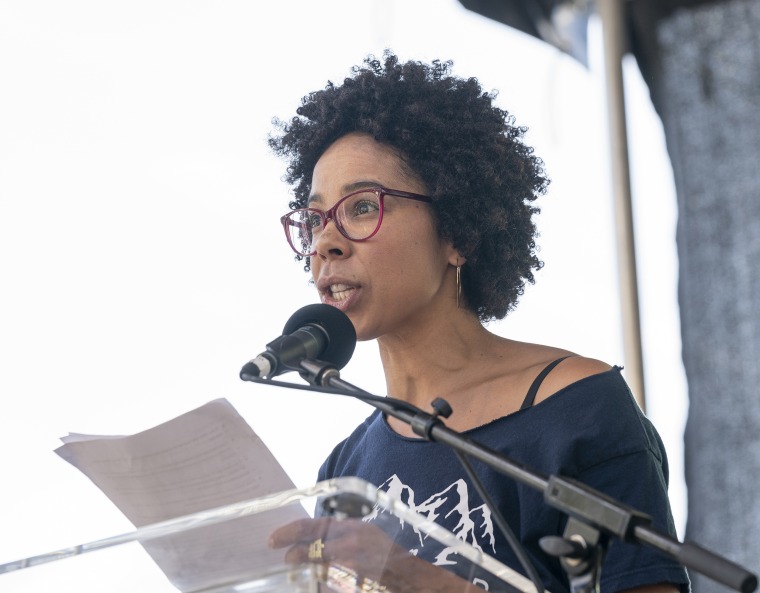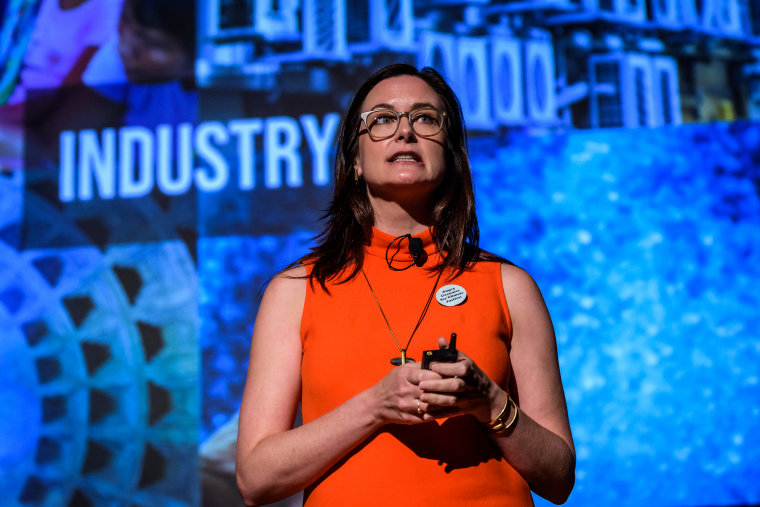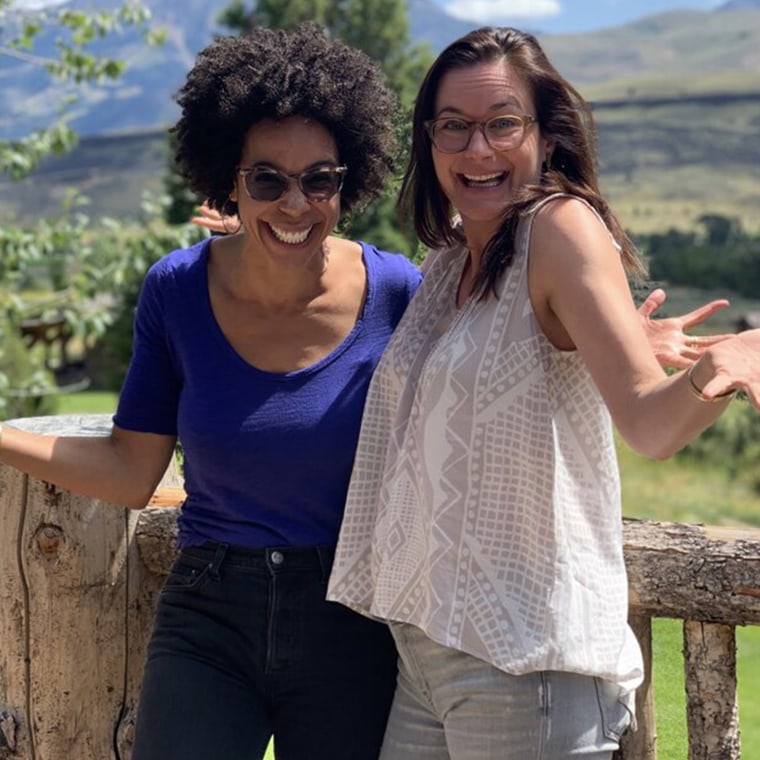We are all works in progress; even the successful women you see owning it on Instagram faced stumbling blocks along the way and continue to work hard to stay at the top of their game. In this series, we're sitting down with the people that inspire us to find out: How'd they do it? And what is success really like? This is "Getting There."
Dr. Ayana Elizabeth Johnson and Dr. Katharine K. Wilkinson are on a mission to bring more women to the forefront of the climate change movement, a field that has long been dominated by white men. Last fall, the pair released an anthology they edited called "All We Can Save," featuring essays from a varied group of experts with diverse perspectives.
"All We Can Save" has since attracted attention from outside the scientific community, and its audiobook is even voiced by Hollywood celebrities like Jane Fonda, Julia Louis-Dreyfus, America Ferrera and Sophia Bush. Here's how they're building a movement and why they say women are so necessary to the climate movement.
TMRW: Ayana, you wear many hats as a marine biologist, podcast host and writer. How did you get your start in the climate world?

Ayana Johnson: I like this version of the question, because I get asked all the time, like, "How did you become a marine biologist?" with just, you know, it's the same answer as every other kid who thinks the ocean is really cool. But ... there's no way to do ocean conservation work without realizing that it's all happening in the context of the climate crisis. And so it was just a slow and steady expansion from trying to figure out what sustainable fishing looked like in Caribbean island nations to thinking about ocean policy at the U.S. federal level, and then realizing that there's a limit to how much you can accomplish if you're just thinking locally. That local work is still critical, of course, but I realized there was an opportunity to be one of the people who was helping to connect those dots between the imperatives for ocean conservation ... and being one of the people who's raising her hand and saying, "Don't forget about the ocean!" in every climate meeting.
Katharine, you’re also an author, teacher and former editor-in-chief of Project Drawdown, a nonprofit coalition of researchers and scientists working on climate change solutions. How did you get your start in the climate world?

Katharine Wilkinson: I got sort of politicized around environmental issues broadly in high school and kind of carried that student activism into my undergraduate years. And I remember at some point ... I want to say, maybe my second year or so in college, I realized that if I wanted to work on environmental issues, that probably meant working on climate change. I learned a lot from a friend of mine in college, Billy Parish, who really got the youth climate movement going. He was kind of my entry point.
What brought you two together?
Wilkinson: Technically, we first met on Twitter. And, you know, I was like ...
Johnson: A very modern story.
Wilkinson: ...this woman seems extremely cool. And then a mutual friend, a colleague in the ocean climate overlap world, sent us an email and said, "You two need to meet." And we hopped on a phone call together. It's very 21st century ... and that was late 2018. And there was sort of an unusual opportunity on the table to curate and lead a retreat at this incredible ranch in Montana. And I'd had this notion of, "Could we get a bunch of women in climate together for community and scheming and dreaming that's hard to do alone?" And Ayana, ... she was like, "Well, I am in and I will help you do that. Let's fire up a spreadsheet and get going."

You say on the All We Can Save website that it's very much a men's world. How did you find this community of women leaders who are ready to break down barriers?
Johnson: Katharine and I were looking around and seeing so much remarkable work happening. That women were leading in these creative ways, forming interesting collaborations, working outside of institutions and just sort of doing what needed to be done, often without nearly enough resources behind them. So when I met Katharine and saw her TED talk about exactly this — the need to include an eye to the gender as we work on addressing the climate crisis — I started to think about what that would mean. And once you start looking around and you notice the incredible work that's going on, that's being done by women that's either under appreciated, underfunded, under recognized, it just seems like such a waste not to figure out how to further bolster those efforts.
How would you describe the All We Can Save Project and its purpose?
Johnson: It's born out of ... this need for gender equality within climate work and the understanding that if we do not deliberately include women, especially women of color, not just as participants, but as leaders, then we won't succeed. We need the biggest, strongest team and we also just need so many more leaders. Katharine has described the climate crisis as a leadership crisis. And that's not just the lack of diversity in the leaders right now, but the fact that we need so many more leaders. We're talking about a moment of radical transformation that's needed in terms of our electricity and transportation and buildings and manufacturing and agriculture and land use and all of that, which means we need leaders in every community, in every sector, leading this transition. And so what we're trying to do is advocate for gender equality within climate work, and welcome as many people in as possible, and see if there are things we can do to help them find their place in this work.
Wilkinson: Elizabeth Yeampierre, who is a longtime climate justice activist and leader, talks about the need for a "leaderful" movement. And I love that I term, because I think it gives you that sense of abundance and a mosaic that we need in terms of climate leadership. I think about All We Can Save sometimes as a kaleidoscope, where you can sort of keep turning it right to see things slightly differently, to have kind of new insights and new openings. And I think a leaderful movement takes that power of a kaleidoscope and just makes it so much bigger.
Johnson: And that term is also used in the movement for Black Lives (Matter). And it's been, of course, remarkable to see how that principle of advocating for a leaderful approach has really played out in their work in these beautiful ways.
What's your response to challenges from doubters and climate change deniers?
Johnson: Well, I think it's important to keep in context that that's actually a very small percentage of people. It's larger in America and the U.S. than it is elsewhere, but there's only about 8% of Americans who are staunchly in denial about climate science, and another 12 or so percent who are dismissive of it. But that leaves nearly 80% of Americans who are concerned to some degree, and then the question becomes, OK, what do we do? And so, we're not in the business of having the the important and very difficult conversations to bring people on board with accepting the science of what's happening. Because we think that our efforts are best focused on the many millions of people who understand the magnitude of a challenge we're facing, and just haven't found a way to really fit in and be helpful in the way things need to move forward. So I don't have fights on Twitter with climate deniers or anything.
What has been the response to All We Can Save?
Johnson: Katharine came up with this brilliant idea of putting together reading circles and developing this 10-week discussion guide that mirrors the 10 sections of the book. And, you know, our PR advisors were like, "You realize no one's going to sign up for this. This is like an AP class; you're asking too much of people." And we've had over 500 people sign up to lead these circles, which means there are probably thousands of people in them having these discussions. And the first wave of folks have been through this 10-week cycle now. And it's just been remarkable to see the feedback of people saying, "Oh, now I see where I can fit in," or "My discussion circle is becoming an accountability circle or an action circle." And so I think figuring out how the book can be a tool for gathering people is something that Katharine's conception of circles has really kicked off in a beautiful way, where people can sort of run with it and use it however they need to.
Wilkinson: I got to teach this book in an undergraduate seminar last fall, right when it came out, and to see firsthand the impact that it had on this group of students in terms of their going, "Oh, climate is not just about science and engineering and policy, it's also about storytelling and journalism and psychology and food," and kind of the way that it opened up their sense of footholds for contributing and participating. And I will never forget one of my students saying, "I was shaking while I was reading it, because I felt so empowered." And I think that's really the bottom line. We want folks to feel like they can and are bringing their superpowers to this work.
So much of our work together has been kind of sensing and reading what's happening. And putting our heads together on, "How can we help? How can we contribute and sort of following the openings that present themselves?" And I think that's going to continue to be true, because we're in this incredibly liminal time of transformation. And there's a lot that we don't know just yet and there's a lot that we're like just beginning to glimpse over the horizon.
This interview has been edited and condensed for clarity.
Ready to take action on climate change? Join us at TODAY Goes Green for more stories like this.
Related: